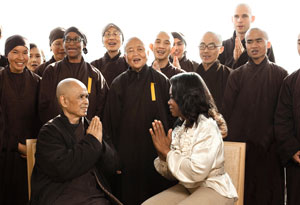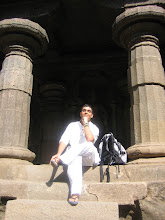
Wednesday, February 17, 2010
Oprah Talks to Thich Nhat Hanh
Here's a really great one. Oprah recently sat down with Thich Nhat Hanh. The entire thing can be read here.


Saturday, February 6, 2010
A Little Break
Greetings everyone! This is my first post in a very, very long time. In fact, it's my first post of 2010! Things have been quite busy for me the past few months and that's not going to change in the immediate future. (I'll give you a clue, it starts with "th" and ends in "esis"!). Thus, the time I have to post is severely limited but I do hope to find the time to post when I get the chance. Once I'm past "the grind", I look forward to returning with the usual amount of posts. For now, enjoy this essay written by Bhikkhu Bodhi which examines the competing arahant-bodhisattva ideals. Here's an excerpt:
And now, it's back to chopping wood and carrying water.

The most archaic Buddhist texts – the Pali Nikāyas and their counterparts from other early schools (preserved in the Chinese Āgamas) – depict the ideal for the Buddhist disciple as the arahant. The Mahāyāna sūtras, composed a few centuries later in a Buddhist Hybrid Sanskrit, depict the ideal for the Mahāyāna follower as the bodhisattva. Now some people argue that because the arahant is the ideal of Early Buddhism, while the bodhisattva is the ideal of later Mahāyāna Buddhism, the Mahāyāna must be a more advanced or highly developed type of Buddhism, a more ultimate teaching compared to the simpler, more basic teaching of the Nikāyas. That is indeed an attitude common among Mahāyānists, which I will call "Mahāyāna elitism." There is an opposing attitude common among conservative advocates of the Nikāyas, an attitude that I will call "Nikāya purism," which rejects all later developments in the history of Buddhist thought as deviation and distortion, a fall away from the "pristine purity" of the ancient teaching. Taking the arahant ideal alone as valid, Nikāya purists reject the bodhisattva ideal, sometimes forcefully.Also on the topic of Bhante, he will be participating in the Sacred Awakening Series, an interactive seminar involving numerous other teachers from a variety of traditions.
I am trying to find a point of view that can do justice to both perspectives, that of the Nikāyas and the early Mahāyāna sūtras, a point of view that can accommodate their respective strengths without falling into a soft and easy syncretism, without blotting out conceptual dissonances between them, without abandoning faithfulness to the historical records (yet which also recognizes that these records are by no means crystal clear and are unlikely to be free of bias). This is by no means easy. It’s much simpler to take either a standpoint of "Nikāya purism" or one of "Mahāyāna elitism" and hold to it without flinching. The problem with these two standpoints, however, is that both are obliged to neglect facts that are discomforting to their respective points of view. Although I am ordained as a Theravāda Buddhist monk, in this paper I’m not going to be defending the opinions of any particular school of Buddhism or trying to uphold a sectarian point of view. My first purpose is to draw out from the texts what they say explicitly, and also what they imply, about these two competing ideals of the Buddhist life. At the end, when I draw my conclusions, I will clearly state them as such, and they will be entirely my own. Sometimes I won’t be drawing conclusions but instead raising questions, pointing to problems in the history of Buddhism that I am acutely aware of but unfortunately cannot solve. It is quite possible that what I consider a nuanced and balanced point of view will draw fire from partisan advocates on both sides of the divide.
And now, it's back to chopping wood and carrying water.

Subscribe to:
Posts (Atom)







